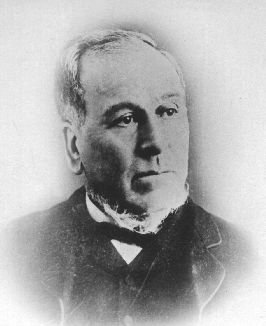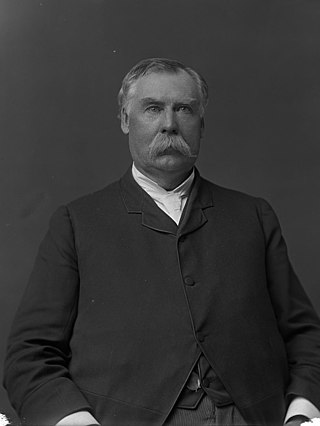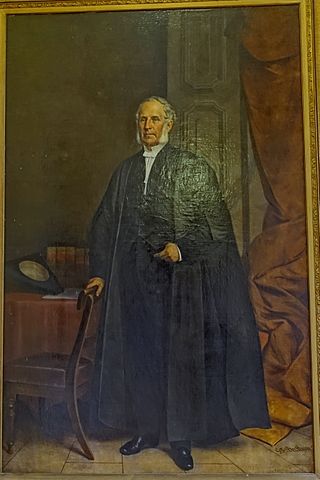
The Judicial Committee of the Privy Council (JCPC) is the highest court of appeal for the Crown Dependencies, the British Overseas Territories, some Commonwealth countries and a few institutions in the United Kingdom. Established on 14 August 1833 to hear appeals formerly heard by the King-in-Council, the Privy Council formerly acted as the court of last resort for the entire British Empire, other than for the United Kingdom itself.
Canadian federalism involves the current nature and historical development of the federal system in Canada.

Sir Oliver Mowat was a Canadian lawyer, politician, and Ontario Liberal Party leader. He served for nearly 24 years as the third premier of Ontario. He was the eighth lieutenant governor of Ontario and one of the Fathers of Confederation. He is best known for defending successfully the constitutional rights of the provinces in the face of the centralizing tendency of the national government as represented by his longtime Conservative adversary, John A. Macdonald. This longevity and power was due to his maneuvering to build a political base around Liberals, Catholics, trade unions, and anti-French-Canadian sentiment.

Arthur Sturgis Hardy, was a Canadian lawyer and Liberal politician who served as the fourth premier of Ontario from 1896 to 1899.

The Constitution Act, 1867, originally enacted as the British North America Act, 1867, is a major part of the Constitution of Canada. The act created a federal dominion and defines much of the operation of the Government of Canada, including its federal structure, the House of Commons, the Senate, the justice system, and the taxation system. In 1982, with the patriation of the Constitution, the British North America Acts which were originally enacted by the British Parliament, including this Act, were renamed. Although, the acts are still known by their original names in records of the United Kingdom. Amendments were also made at this time: section 92A was added, giving provinces greater control over non-renewable natural resources.
The Federal Court of Canada, which succeeded the Exchequer Court of Canada in 1971, was a national court of Canada that had limited jurisdiction to hear certain types of disputes arising under the federal government's legislative jurisdiction. Originally composed of two divisions, the Appellate Division and the Trial Division, in 2003 the Court was split into two separate Courts, the Federal Court and the Federal Court of Appeal. The jurisdiction and powers of the two courts remained largely unchanged from the predecessor divisions.

The Province of Ontario is governed by a unicameral legislature, the Legislative Assembly of Ontario, which operates in the Westminster system of government. The political party that wins the largest number of seats in the legislature normally forms the government, and the party's leader becomes premier of the province, i.e., the head of the government.

St Catharines Milling and Lumber Co v R was the leading case on Aboriginal title in Canada for more than 80 years. The Judicial Committee of the Privy Council, affirming a ruling by the Supreme Court of Canada, held that Aboriginal title over land was allowed only at the Crown's pleasure, and could be taken away at any time. This case, involving Ojibway Treaty No. 3 which had never been previously litigated before any court, is a leading decision in Canada on the differences between the division of legislative powers and property rights under the Constitution of Canada.

Hodge v R is a famous Privy Council decision on interpreting the Constitution of Canada. This was the first time the doctrine of double aspect was applied to division of powers analysis.

Citizens Insurance Co of Canada v Parsons is a major Canadian constitutional case decided by the Judicial Committee of the Privy Council, at that time the highest court of appeal for the British Empire. The case decided a significant issue of the division of powers between the federal Parliament and the provincial legislatures. The approach taken to provincial power, as advocated by Premier Oliver Mowat of Ontario, began to set the constitutional framework for broad provincial powers and a reduction in the centralist vision of Confederation espoused by Prime Minister John A. Macdonald.

Ontario (AG) v Canada Temperance Federation was a famous Canadian constitutional decision of the Judicial Committee of the Privy Council and was among the first cases to examine the peace, order, and good government power of the Constitution Act, 1867. It was the first decision to bring back the "national concerns" branch of peace, order and good government since it was first suggested in the Local Prohibitions case.

The Canada Temperance Act, also known as the Scott Act, was an Act of the Parliament of Canada passed in 1878, which provided for a national framework for municipalities to opt in by plebiscite to a scheme of prohibition. It was repealed in 1984.

R v Eastern Terminal Elevator Co is an early constitutional decision of the Supreme Court of Canada on the Constitution's Trade and Commerce power.

William Durie Lyon was a merchant and political figure in Ontario, Canada.

Peter McLaren was a Canadian politician and Senator from Ontario. McLaren was the Plaintiff in McLaren v Caldwell, that resulted in the landmark decision of the Judicial Committee of the Privy Council that upheld provincial jurisdiction in matters of a local or private nature, as well as over property and civil rights.
Loring, Port Loring and District is a local services board in the Canadian province of Ontario, located in Parry Sound District, and by extension, the Almaguin Highlands region.

Section 91 of the Constitution Act, 1867 is a provision in the Constitution of Canada that sets out the legislative powers of the federal Parliament. The federal powers in section 91 are balanced by the list of provincial legislative powers set out in section 92 of the Constitution Act, 1867. The dynamic tension between these two sets of legislative authority is generally known as the "division of powers". The interplay between the two lists of powers have been the source of much constitutional litigation since the Confederation of Canada in 1867.

The Canadian Navigable Waters Act is one of the oldest regulatory statutes enacted by the Parliament of Canada. It requires approval for any works that may affect navigation on navigable waters in Canada.

John Godfrey Spragge was a Canadian lawyer and judge.
Disallowance and reservation are historical constitutional powers in Canada that act as a mechanism to delay or overrule legislation passed by Parliament or a provincial legislature. In contemporary Canadian history, disallowance is an authority granted to the governor general in council to invalidate an enactment passed by a provincial legislature. Reservation is an authority granted to the lieutenant governor to withhold royal assent from a bill which has been passed by a provincial legislature. The bill is then "reserved" for consideration by the federal cabinet.















